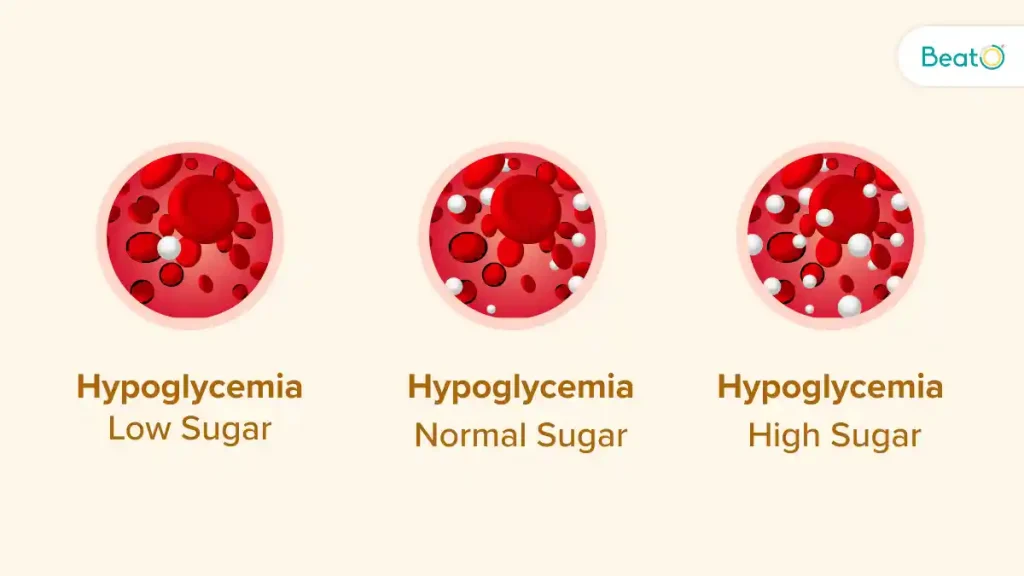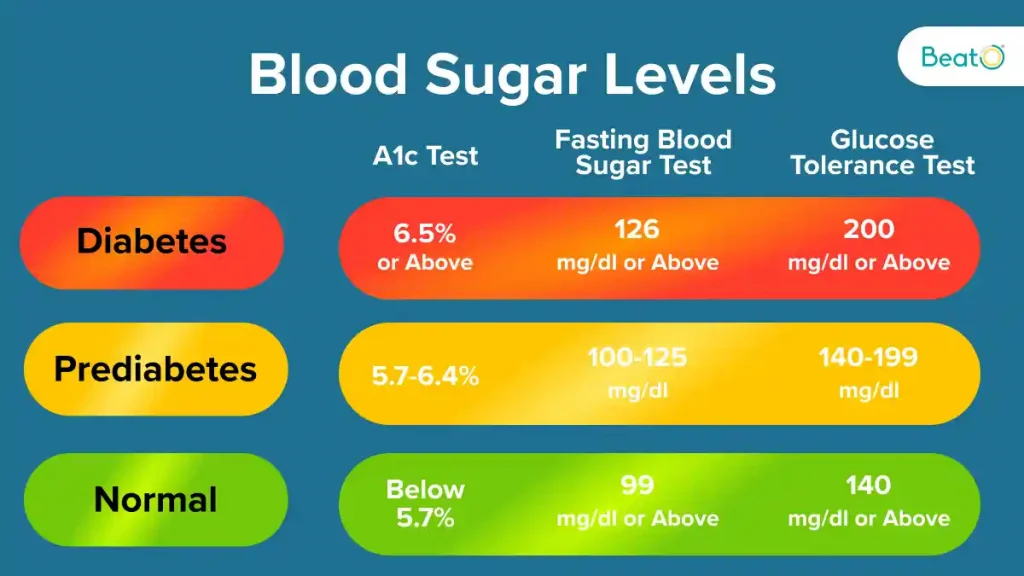When it comes to maintaining good health, understanding your body’s fasting Blood Sugar level is crucial. Glucose, a type of sugar, is the primary source of energy for our body. It’s derived from the foods we eat, and its levels can fluctuate based on various factors, such as diet, exercise, stress, and illness. One important measure of glucose levels is the fasting blood glucose level, which is taken after an individual has not eaten for at least eight hours. Let’s get a better understanding of what fasting blood sugar levels are and how they relate to normal blood sugar levels.

Also Read: Benefits Of Magnesium Rich Foods To Elevate Your Nutrition
Fasting Sugar Level
To understand what is Fasting Blood Sugar level we need to first understand what exactly is blood sugar and fasting blood sugar.
What Is Blood Sugar?

When there is too much glucose (sugar) in your system, it is referred to as high blood sugar (also known as hyperglycemia or high blood glucose). This is usually the result of your body not using or making insulin as it should. One hormone that aids in blood sugar regulation is insulin.
Normally, after a meal, for example, or when blood glucose levels rise, your pancreas releases insulin. This instructs the body to continue absorbing glucose until the levels return to normal.
However, diabetes is a condition in which your body either fails to produce insulin (type 1 diabetes) or fails to react to it appropriately (type 2 diabetes). You might have too much blood sugar for too long as a result. This can harm blood vessels and nerves over time, resulting in heart disease and other issues.
Also Read: Indulge Responsibly: Diabetes-friendly Jhangore Ki Kheer Recipe
What Is Fasting Blood Sugar Level?

The fasting blood sugar test is used to identify conditions such as type 2 diabetes, prediabetes, and gestational diabetes. These conditions often don’t show symptoms in the early stages, leaving many individuals unaware of increased blood sugar levels. However, Regular monitoring of fasting blood sugar levels can help detect diabetes in time. This test is also performed during pregnancy to check for diabetes caused by hormonal changes, known as gestational diabetes.
Before undergoing a fasting blood sugar test, you’ll be required to abstain from consuming food or drink (other than water) for approximately 8 hours. This is a standard protocol which is why many doctors and healthcare professionals prefer to have the fasting sugar level test done in the morning before breakfast.
The procedure involves drawing blood into a vial via a needle inserted into a vein in the elbow region. After drawing the blood, pressure is applied to the area to halt bleeding, followed by the application of a bandage. The collected blood sample is then sent to a laboratory for analysis.
Post-test, you might experience minor pain or notice a bruise at the site where the needle was inserted. However, these symptoms are temporary and should subside in a few days.
Also Read:Top 10 Health Benefits of Sprouted Moong: Unveiling the Diabetic’s Nutrient-Rich Secret
What Should My Blood Sugar Be Before Eating?
Blood sugar, also known as glucose, is a key energy source for the body. It’s derived from the food we eat and fluctuates throughout the day based on various factors such as diet, physical activity, and stress. One of the most critical times to monitor these levels is before eating, often referred to as pre-meal or fasting glucose levels.
So, what should your blood sugar be before eating? For most individuals without diabetes, normal blood sugar levels before meals hover around 70 to 80 mg/dL. However, these numbers aren’t set in stone and can vary among individuals. For some, a pre-meal glucose level of 60 mg/dL may be their normal, while for others, it could be around 90 mg/dL.
Maintaining optimal pre-meal glucose levels ensures that your body has enough energy to function properly without causing hyperglycemia (high blood sugar) or hypoglycemia (low blood sugar). Both conditions can lead to serious health complications if left unchecked.
For individuals with diabetes, managing these pre-meal glucose levels becomes even more critical. The Centers for Disease Control and Prevention (CDC) recommends a target pre-meal glucose level of 80-130 mg/dL for adults with diabetes. Remember, though, these figures serve only as guidelines. Individual targets may vary based on several factors including age, duration of diabetes, risk of hypoglycemia, and overall health. Therefore, it is essential to discuss your glucose targets with your healthcare provider.
Also Read: Travelling with Diabetes: 5 Tips for Using a Glucometer on the Go
Prediabetes and Diabetes
If your fasting glucose levels are consistently above this range, it may indicate a condition known as prediabetes. Prediabetes is a state where blood glucose levels are higher than normal but not high enough to be classified as diabetes. For individuals with prediabetes, fasting glucose levels usually fall between 100 and 125 mg/dL.
A diagnosis of diabetes, on the other hand, is typically given when fasting glucose levels are 126 mg/dL or higher on two separate tests. This chronic disease is characterized by the body’s inability to effectively regulate blood glucose levels, leading to consistently high levels that can cause numerous health problems if left unmanaged.
Also Read: Exploring 10 Health Benefits of Ragi (Finger Millet)
Why Fasting Blood Sugar Level Matter
Monitoring fasting glucose levels is essential because it helps identify potential issues with insulin production or effectiveness. Insulin, a hormone produced by the pancreas, plays a vital role in regulating glucose levels.
In healthy individuals, insulin ensures that glucose enters cells to be used as energy, keeping blood glucose levels stable. However, in individuals with prediabetes or diabetes, this process is disrupted, leading to elevated glucose levels.
Regular testing of fasting glucose levels can help identify prediabetes or diabetes early, enabling individuals to take steps to manage the condition and prevent or delay the onset of complications.
Read More:Top 10 Health Benefits of Jowar (Sorghum)
Maintaining Healthy Fasting Blood Sugar Level
Maintaining healthy fasting blood sugar level is crucial for overall health, especially for those with conditions like diabetes. Here are some ways to naturally lower and manage your blood sugar levels.
- Regular Monitoring: Monitoring your blood sugar levels consistently can help you understand what causes them to increase or decrease. It’s also important to maintain a regular eating schedule and avoid skipping meals.
- Physical activity: Regular exercise can effectively bring down glucose levels. While exercising in the evening might help lower morning blood sugar, it’s important to note that it comes with some risks.
- Well-balanced diet: A balanced diet rich in fruits, vegetables, and moderate amounts of carbohydrates can help control blood sugar. Consuming foods lower in calories, high in fibre, and managing your carb intake can be beneficial. Having a well-balanced diet can improve your blood sugar level which is vital during pregnancy, for the health of your baby.
It is vital to regularly maintain blood sugar levels to prevent long-term serious health problems, such as heart disease, kidney disease, and vision issues. For those who are non-diabetic fasting sugar levels can help diagnose conditions if you’re experiencing any serious symptoms.
Also Read: Winter Wellness: Strategies for Reversing Diabetes and Insulin Resistance
Conclusion
Maintaining a fast of at least 8 hours before measuring your fasting sugar levels, during which you’ve consumed nothing but water, can provide valuable information for both individuals with diabetes and those without. This information can assist in fine-tuning your insulin levels or adjusting the dosage of diabetes medications. It also aids in the detection of diabetes, even in the absence of symptoms.
Disclaimer:The content of this article is compiled information from generic and public sources. It is in no way a substitute, suggestion, or advice for a qualified medical opinion. Always consult a specialist or your own doctor for more information. BeatoApp does not claim responsibility for this information .
Dr. Navneet Agarwal is an established and highly skilled Diabetology with over 25 years of experience in Diabetology & Obesity. He is well-regarded for his quality and patient-centered diabetes care. Also, keep track of your blood sugar levels with a Doctors’ approved smart glucometer and elevate your healthcare routine.




